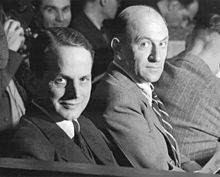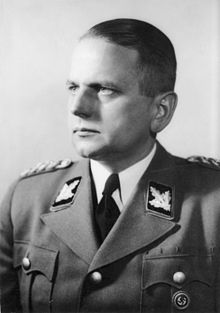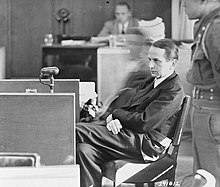Otto Ohlendorf
Otto Ohlendorf (born February 4, 1907 in Hoheneggelsen ; † June 7, 1951 in Landsberg am Lech ) was a German war criminal , SS group leader and lieutenant general of the police, commander of Einsatzgruppe D and head of office ( SD -Inland) in the Reich Main Security Office (RSHA) . He was sentenced to death in 1948 and executed in 1951.
Life
After finishing school at the Andreanum grammar school in Hildesheim , he studied law and political science at the universities of Leipzig and Göttingen . In 1925 he joined the NSDAP ( membership number 6.531) and SS (SS number 880); in the following year Ohlendorf SA became a member. This made Ohlendorf an " old fighter " and accordingly later received the golden party badge .
After academic positions at the Institute for World Economy in Kiel and at the University of Berlin , he became an economic consultant in the security service of the Reichsführer SS (SD) in 1936 . From 1939 to 1945 he was head of Office III (German areas of life) of the RSHA. Here he was responsible for creating reports from the Reich . These reports sought to inform the government about the current mood among the population.
After the German invasion of the Soviet Union in 1941 , on instructions from Heinrich Himmler, he also commanded Einsatzgruppe D, which operated in southern Ukraine and the Caucasus, until June 1942. The task of the SS Einsatzgruppen was to destroy the Jews and Gypsies living in the conquered areas, as well as the leading cadres of the Communist Party of the Soviet Union . Ohlendorf was thus responsible for the murder of around 90,000 people. He expressly gave the order to the Einsatzgruppen chiefs and confirmed it on August 1, 1941, “that in future all captured Jews should be shot for racial reasons ”.
At the end of 1943, Ohlendorf also became Deputy State Secretary in the Reich Ministry of Economics . There he coordinated the planning for the economy after the war - actually forbidden, but Himmler rejected the given, but in his opinion "totally Bolshevik " economic control Albert Speer and protected the post-war planning . In this sense, Ohlendorf also worked with Ludwig Erhard and many other business experts. In peacetime, the bureaucratic steering apparatus had to be replaced by “active and daring entrepreneurship”, according to Ohlendorf.
In the last days of the war he fled to Flensburg via the Rattenlinie Nord .
Task Force Process

In the trial against the main war criminals in Nuremberg, Ohlendorf was one of the main witnesses for the prosecution. Without emotion he described the mass murders of his task force in detail . At the same time, he aroused displeasure among the accused, especially Hermann Göring , who accused him of unnecessarily burdening himself and the other perpetrators with his truthful descriptions.
In the Einsatzgruppen trial he was sentenced to death in 1948 . In the proceedings, the defense tried in vain and contrary to the facts, to portray Ohlendorf as an accomplice who tended to be opposition and who had not committed any murders, but only received orders. His deputy Willi Seibert and his adjutant Heinz Schubert were also on trial with him. Despite an amnesty campaign, even high church dignitaries and members of the Federal Government in the Allied High Commissioner inserting for a pardon, Ohlendorf was on 7 June 1951 war Landsberg prison by the train executed. The pastoral care on the executions took over the Nazi and pastor of the anthroposophic Christian Community Werner Georg Haverbeck .
The body was buried in his hometown Hoheneggelsen. Letters from Ohlendorf to a Hildesheim school friend, his wife and others during his imprisonment from 1947 to 1950 are kept in the Hildesheim City Archives.
Publications and documents
- German domestic trade. Essence and task. Elsner Verlagsgesellschaft, Berlin / Vienna / Leipzig 1942. Was placed on the list of literature to be segregated in the Soviet occupation zone after the end of the war .
- Affidavit (1) , Affidavit (2) . In: John Mendelson (Ed.): The Holocaust, Selected Documents in Eighteen Volumes. Volume 10. New York / London 1982 ( facsimile )
literature
- Heinz Boberach: Ohlendorf, Otto. In: New German Biography (NDB). Volume 19, Duncker & Humblot, Berlin 1999, ISBN 3-428-00200-8 , p. 485 f. ( Digitized version ).
- Martin Holler: Extending the Genocidal Program: Did Otto Ohlendorf Initiate the Systematic Extermination of Soviet "Gypsies"? in: Alex J. Kay , Jeff Rutherford, David Stahel (Eds.): Nazi Policy on the Eastern Front, 1941: Total War, Genocide, and Radicalization . University of Rochester Press 2012 ( ISBN 978-1580464888 ), pp. 267-288.
- Ilka Richter: SS elite in court. The death sentences against Oswald Pohl and Otto Ohlendorf . Tectum, Marburg 2011, ISBN 978-3-8288-2563-5 .
- Christian Ingrao : Hitler's Elite. The pioneers of the National Socialist mass murder. Translated by Enrico Heinemann & Ursel Schäfer. Propylaeen, Berlin 2012 ISBN 9783549074206 ; again Federal Agency for Civic Education BpB, Bonn 2012, ISBN 9783838902579 (first Paris 2010).
- Hilary Earl: The Nuremberg SS-Einsatzgruppen Trial, 1945–1958: Atrocity, Law, and History. Cambridge University Press, Cambridge 2009, ISBN 978-0-521-45608-1 .
- Jason Weber: Normality and Mass Murder. The example of the task force leader Otto Ohlendorf. In: Joachim Perels , Rolf Pohl (ed.): Nazi perpetrators in the German society Offizin-Verlag, Hanover 2002, ISBN 3930345374 , pp. 41–68.
- David Kittermann: Otto Ohlendorf - " Guardian of the Grail of National Socialism" . In: Ronald Smelser , Enrico Syring (ed.): The SS: Elite under the skull. Paderborn: Schöningh, 2000 ISBN 3-506-78562-1 , pp. 379-393
- Hanno Sowade: OO - nonconformist, SS leader and economic functionary. In: Ronald Smelser , Enrico Syring & Rainer Zitelmann (eds.): The brown elite. Volume 1: 22 biographical sketches. 4th updated edition. WBG, Darmstadt 1999, ISBN 3534144600 , pp. 188-220.
- Arfst Wagner : Anthroposophists and National Socialism. In: Flensburger Hefte. No. 32. Flensburg 1991, ISBN 392684132X .
Web links
- Literature by and about Otto Ohlendorf in the catalog of the German National Library
- Newspaper article about Otto Ohlendorf in the 20th century press kit of the ZBW - Leibniz Information Center for Economics .
- War Criminal Prison No. 1 in Landsberg: The last seven people executed in War Criminal Prison
Individual evidence
- ↑ Andrej Angrick: Clean murderers
- ^ Andrej Angrick : Occupation Policy and Mass Murder. Task Force D in the southern Soviet Union 1941–1943. Hamburger Edition , Hamburg 2003, ISBN 3-930908-91-3 , p. 181; quoted in Regina Reinsperger: Otto Ohlendorf ( Memento from October 12, 2011 in the Internet Archive ).
- ↑ . See Michael Brack man in Handelsblatt : The D-Day . June 25, 2006
- ↑ Stephan Link: "Rattenlinie Nord". War criminals in Flensburg and the surrounding area in May 1945. In: Gerhard Paul, Broder Schwensen (Hrsg.): Mai '45. End of the war in Flensburg. Flensburg 2015, p. 21.
- ↑ Marc von Lüpke, DER SPIEGEL: Mass murders of the Nazis: What SS leader Otto Ohlendorf said - DER SPIEGEL - history. Retrieved May 28, 2020 .
- ^ University of Missouri – Kansas City : Famous Trials - Nuremberg Trials: The Einsatzgruppen Case ( memento of July 8, 2009 in the Internet Archive ) with the verdict in the Ohlendorf case ( memento of March 5, 2008 in the Internet Archive ).
- ^ Ilka Richter: SS elite in court. The death sentences against Oswald Pohl and Otto Ohlendorf. Tectum, Marburg 2011, p. 84 ff.
- ↑ Michael Brackmann Erhard's double coup in General-Anzeiger Bonn, pp. 10f, June 18, 2018
- ↑ Joachim Käppner : A farewell to legends and life lies. In: sueddeutsche.de . March 24, 2011, accessed March 26, 2011 .
- ↑ Martin Hartmann: “Dear Schorse!” - Letters from a war criminal (PDF; 20 kB). Historical documents from the city archive, volume 46, Hildesheim city archive.
- ^ German administration for popular education in the Soviet occupation zone, list of literature to be sorted out. Transcript letter O, pages 300-306. Retrieved June 4, 2018 .
- ↑ hu-berlin.de
| personal data | |
|---|---|
| SURNAME | Ohlendorf, Otto |
| BRIEF DESCRIPTION | German SS general, commander of a task force and head of office in the Reich Security Main Office (RSHA) |
| DATE OF BIRTH | February 4, 1907 |
| PLACE OF BIRTH | Hoheneggelsen |
| DATE OF DEATH | June 7, 1951 |
| Place of death | Landsberg |


